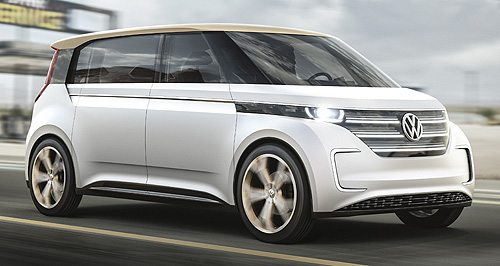Drive buddy: Volkswagen's all-electric van concept has made its debut at the Consumer Electronics Show in Las Vegas, showing off a versatile range and innovative user interaction features.
Gallery

Click to see larger images
VOLKSWAGEN has unveiled an all-electric compact van dubbed Budd-e at the Consumer Electronics Show (CES) in Las Vegas in both a nod to its people-movers of the past and a significant step forward to the future.
The concept is the first car to be based on the German car-maker's electric-specific MEB platform and sets a new standard in range and charging times, with a four-wheel-drive powertrain that can take it 533km and be charged to 80 per cent in about 30 minutes.
The current production electric car fast-charging standard has been set by Tesla's Model S which can take a half charge in about 20 minutes, but Volkswagen is predicting its 80 per cent top-up benchmark will fall to just 15 minutes before 2019.
No production version has been confirmed for the little van at this stage but VW says its first MEB-based concept “opens a gateway to the immediate future,” potentially paving the way for more dedicated electric concepts and ultimately a road-going version.
Its electric-specific platform has allowed the interior space to be maximised while keeping exterior dimensions in the ball park of more conventional small vans placing it somewhere between the company's existing Touran and Multivan commercial vehicles.
At 5497mm long, 1940mm wide and 1835mm tall, the Budd-e is 317mm longer, 220mm wider but 105mm shorter than Volkswagen's original Type 2 bus that was introduced in the early 1950s.
A 100kW motor drives the front wheels, while a 125kW version deals with the rear axle, drawing power from a 92.4kWh battery hidden under the floor. The little van can accelerate from zero to 100km/h in 6.9 seconds and on to a top speed of 180km/h.
In addition to its impressive range and charging time, the Budd-e introduces innovations in connectivity and human interaction.
Its interior is “more reminiscent of a lounge”, according to Volkswagen, and is kept spacious and minimal by the removal of conventional switches and controls. Instead, the various comfort and entertainment features can be accessed with gesture controls or the human-machine interface, which looks like “a tablet floating in the space in front of the driver.” Voice control is also available and is simply activated by saying “hello Budd-e” and responds to natural spoken instructions such as “turn the heat up a bit, please.” If a rear passenger tells the car they are too hot, sensors can tell where the remark came from and the temperature is only adjusted in that area.
The driver receives in formation from a programmable 12.3-inch Active info Display, while other occupants can use the 13.3-inch dashboard monitor, which is laid out like a smartphone.
The front passenger seat can be rotated to face the rear passengers and the 34-inch monitor mounted on the side of the Budd-e, and the whole interior is bathed in blue and white light.
Both sliding side and rear doors are opened by gesturing at them rather than contacting any part of the van or key fob.
The concept also introduces what some manufacturers are referring to as “the internet of things” which allows everyday household objects including cars to share information, allowing a user to stay connected to the internet wherever they are.
In cooperation with major consumer electronics brands such as LG, Apple and Android smartphone manufacturers, occupants of the Budd-e will be able to connect to their “smart home” and see what is in the fridge, who is at home and control household functions such as lighting and temperature.
The control can be used in reverse to set a temperature in the vehicle or program a music playlist before climbing aboard. Songs can even be cued to play automatically at specific points in the journey.
When a wearable smart device or phone is connected to the car, the Budd-e can remind the user if they have left something important in the vehicle such as a tablet, or also issue helpful reminders to take specific things such as an umbrella if the weather forecast is for rain.
Like many vehicles from various manufacturers at the CES this year, the Budd-e also showcases autonomous driving features as demonstrated by Audi's A7 piloted driving concept which covered 900 driverless kilometres in 2015, and the Volkswagen e-Golf Perfect Parking, which found its own way to a charging point at last year's CES.
Volkswagen recently announced it would divert funding from some projects to resolve the unfolding diesel emissions scandal, but investments in electric vehicle development were safe, and some green projects would even receive increased support.

Facebook Twitter Instagram